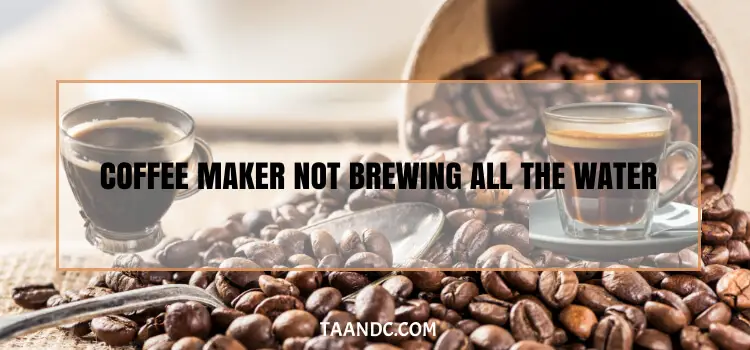Why does my coffee taste watery? Ah, a question that's genuinely puzzled many a coffee enthusiast, including yours. After years of brewing my morning cup, I've realized a few common culprits behind this less-than-satisfying experience. Firstly, it's all about the ratio. Using too much water or too little coffee grounds can produce that undesirable watery taste. Secondly, the grind size plays a pivotal role. Opting for a coarse grind can result in a weak brew. And let's not forget about brewing time - if it's too short, your coffee might lack that robust flavor we all crave. Stay tuned for some tried-and-true tips to elevate your coffee game!

What is Watery Coffee?
Watery coffee is a common woe for many coffee enthusiasts, and it's exactly what it sounds like - a brew that lacks the rich, robust flavor and body we expect from our morning cup. Instead of that satisfying, bold kick, watery coffee often leaves us with a weak and bland taste. Several factors can contribute to this disappointing outcome, from improper brewing ratios to inadequate grind size. In the following sections, we'll delve into the critical reasons behind watery coffee and explore practical solutions to ensure every brew packs the punch of flavor we crave.
The Causes of Watery Coffee
Watery coffee can be attributed to a combination of factors, each playing a pivotal role in the final brew. Weak coffee concentration, often stemming from inadequate coffee-to-water ratios or grind size, dilutes the flavor profile. Incorrect brewing methods, like improper water temperature or insufficient steeping time, can also lead to a lackluster outcome.
Read Also: What Does 1/4 Of A Can Of Coffee Cost
The coffee-to-water ratio is crucial; too much water relative to the coffee grounds results in a less concentrated brew. Similarly, a grind size that's too coarse offers less surface area for flavor extraction, leading to a milder taste. In essence, these factors collectively impact the overall taste and strength of the coffee, underscoring the importance of precision in the brewing process.
Coffee Grind Size
Selecting the right grind size is critical to achieving that perfect coffee cup. It's often underestimated, yet it plays a pivotal role in extraction. From coarse to fine, each grind size brings nuances to the brew, influencing flavor, aroma, and strength.
Read Also: Why Does My Keurig Coffee Pot Leak When I Pour
We'll explore the impact of various grind sizes on the brewing process, helping you understand how this small detail can make a difference in your daily coffee ritual. Whether you're a seasoned barista or just starting your coffee journey, mastering grind size is a game-changer for elevating your coffee experience.
Effect of Coarse vs. Fine Grind on Taste
The choice between a coarse or fine grind size significantly shapes the taste profile of your coffee. Coarse grinds, characterized by larger particles, yield a milder brew. This is because flavor extraction has less surface area, resulting in a gentler, albeit potentially weaker, taste. On the other hand, fine grinds, with their smaller particles, can lead to over-extraction.
Read Also: How To Make Coffee In Cv1 Coffee Maker
This occurs when the water extracts too much from the grounds, often resulting in a bitter aftertaste. To ensure optimal flavor, using freshly ground coffee is crucial, as pre-ground varieties can lose their aromatic oils and nuances over time. Understanding the impact of grind size is a pivotal step towards crafting your perfect cup of coffee tailored to your taste preferences.
Adjusting the Grind Size to Improve Flavor
Fine-tuning your grind size can be a game-changer for that perfect cup of coffee. It's a delicate dance that hinges on understanding the intimate relationship between grind size and flavor extraction. Opt for a finer grind for a bolder, more robust taste. This increases the surface area exposed to hot water, allowing for a more thorough extraction of flavors. Conversely, a coarser grind slows extraction, resulting in a milder brew.
A fine grind is paramount for espresso machines, while a French press benefits from a rougher texture. However, feel free to experiment. Trying different grind sizes is the key to discovering your ideal flavor profile, ensuring every sip is a tailored delight.
Brewing Process and Methodology
Behind every exceptional cup of coffee lies a thoughtful and precise brewing process. From selecting the beans to mastering the grind size, each step contributes to the final flavor profile. The choice of brewing method, whether it's a classic drip, a meticulous pour-over, or the intense pressure of an espresso, further refines the outcome.
In the following sections, we'll delve into the intricacies of each stage, uncovering the secrets to extracting the fullest potential from your coffee beans. So, whether you're a seasoned barista or just beginning your coffee journey, understanding the brewing process and methodology is your ticket to a consistently extraordinary cup of joe.
Drip Coffee Maker Methodology
Using a drip coffee maker is a straightforward yet precise process that guarantees a consistently delicious brew. First, ensure the water-to-coffee ratio is correct - typically, one to two tablespoons of coffee grounds for every six ounces of water. This provides a balanced extraction of flavors.
The water temperature is equally crucial, ideally falling between 195 to 205 degrees Fahrenheit for optimal brewing. Begin by preparing the coffee grounds, ensuring they're coarsely ground to facilitate even extraction.
Next, measure the water precisely and pour it into the machine's reservoir. As the water heats up, it's carefully distributed over the grounds, allowing the brewing process to commence. The result? A perfect cup of drip-brewed coffee, rich in flavor and aroma, ready to kickstart your day.
Espresso Machine Methodology
Mastering the art of espresso brewing requires finesse and precision. Here's a breakdown of the methodology to achieve that perfect shot. Firstly, pay careful attention to the grind size. A fine grind is essential for espresso, creating the right surface area for optimal extraction. The coffee-to-water ratio is equally crucial - typically one ounce of coffee to every two ounces of water. Now, onto the extraction process.
The machine's pump applies the necessary pressure, usually between 9 and 15 bars, to force hot water through the compacted coffee grounds. This high pressure is vital for extracting the intense flavors and aromas that define a good espresso. Be wary of potential pitfalls, like using a coarse grind or not tamping the coffee grounds firmly enough.
These missteps can result in watery espresso shots, lacking the depth and richness characteristic of a well-brewed espresso. With the proper technique, your espresso machine can be a gateway to exceptional coffee experiences.
French Press Methodology
Brewing coffee with a French Press is a delightful, hands-on process that yields a rich and full-bodied cup. To begin, a coarse grind size ensures a smooth and even extraction. The recommended coffee-to-water ratio is about one ounce for every 15 ounces. Pour hot water off the boil after adding the coffee grounds to the press.
Then, let the brew steep for about four minutes. This allows the flavors to infuse, resulting in a robust brew. Finally, with a steady hand, slowly press down the plunger to separate the grounds from the liquid. This simple yet effective methodology delivers a satisfying cup of coffee, showcasing the intricate flavors of your chosen beans.
Cold Brew Methodology
Cold brew coffee is a wonderfully refreshing alternative known for its smooth, mellow flavor. The process is straightforward yet requires a bit of patience. Begin by combining coarsely ground coffee with cold water, maintaining a ratio of roughly one cup of coffee to four cups of water. This proportion allows for a balanced extraction without the risk of a watery taste. The magic happens during the steeping phase, typically 12 to 24 hours.
This extended duration ensures a gradual, full-bodied extraction of flavors, resulting in a delightful cold brew concentrate. The optimal water temperature for this process ranges between 36 to 68 degrees Fahrenheit, guaranteeing a nuanced, well-rounded taste. With a bit of planning and the proper ratio, you'll have a batch of cold brew ready to be enjoyed, providing a perfect respite from warmer days.
Instant Coffee Methodology
Brewing instant coffee is a quick and convenient way to enjoy a cup of joe, but it has its own considerations. The methodology is relatively straightforward: boil water and add it to a cup containing the desired amount of instant coffee granules. However, it's essential to note that instant coffee can sometimes result in a milder or watery taste compared to freshly brewed coffee.
Suppose you find your instant coffee needs more strength and depth. In that case, you can add more coffee granules to intensify the flavor. However, it may not match the richness of freshly brewed coffee. While instant coffee provides unparalleled convenience, it may require some personalization to achieve your desired flavor and satisfaction.
Factors Affecting Brewing Time and Temperature
The art of brewing coffee hinges on two critical elements: time and temperature. The interplay of these factors profoundly influences the flavor profile of your cup. Water temperature is a linchpin in this process, with the sweet spot falling between 195-205 degrees Fahrenheit. This range allows optimal flavor extraction, balancing under and over-extraction. It's worth noting that different roast levels demand slight temperature adjustments. Lighter roasts shine brightest with slightly cooler water, around 195 degrees.
In comparison, darker roasts benefit from the upper end of the range at 205 degrees, ensuring a robust flavor release. Beyond temperature, steeping time is a vital consideration, particularly in cold brew. For the most decadent flavor, a minimum of 12-18 hours of steeping is recommended, allowing for a gradual and comprehensive extraction process. Understanding these factors empowers coffee enthusiasts to tailor their brewing process for a cup that suits their taste preferences perfectly.
Water-to-Coffee Ratio for Optimal Flavor
Achieving the perfect brew is a delicate dance of elements, and none is as crucial as the water-to-coffee ratio. This balance determines your cup's strength, body, and flavor profile. More water can result in a lackluster, weak brew, while too little can lead to an overpowering, overly concentrated concoction. In the sections ahead, we'll explore the art and science behind finding the optimal water-to-coffee ratio, ensuring that every sip is a symphony of flavor tailored precisely to your taste.
Best Ratio for Different Methods of Brewing
The art of brewing coffee extends beyond the beans and the grind; it hinges on the precise ratio of coffee to water. This ratio wields significant influence over the flavor and strength of your brew. Each brewing method demands its own tailored balance for optimal results, whether it's the immersion magic of a French press, the meticulous pour-over technique, or the slow, cold infusion of cold brew.
For instance, a French press tends to shine with a ratio of 1:15. At the same time, a pour-over leans towards 1:17. Cold brew, on the other hand, calls for a more concentrated mix, typically at 1:4 or 1:8. However, these are mere guideposts; personal preference reigns supreme. Don't hesitate to experiment and adjust the ratio until you've brewed the perfect cup that caters precisely to your taste buds. The journey to the ideal coffee-to-water balance is an adventure worth embarking upon for a truly customized coffee experience.
Impact of Too Much or Too Little Water on Taste
The water-to-coffee ratio in the brewing process wields a profound influence over the final flavor of your cup. Using too much water can lead to a brew that tastes weak and needs more boldness, which we often crave.
The excess liquid dilutes the flavors, resulting in a milder and less satisfying experience. Conversely, employing too little water creates an overly concentrated concoction, giving rise to an intense and potentially bitter taste. This imbalance in the water-to-coffee ratio can lead to a discordant brew that needs to capture the nuanced flavors locked within the coffee grounds. Striking the proper equilibrium is the key to ensuring every sip is a harmonious symphony of taste and strength.
FAQ
Why does my coffee taste watery even though I use the same amount of coffee grounds and water every time?
Coffee can taste watery if the grind size needs to be corrected or your brewing method does not extract flavors efficiently. It’s essential to ensure your grind size and brewing process are consistent.
How can I fix watery coffee using a French press?
Adjusting the coffee-to-water ratio by using more coffee grounds or increasing the steeping time can strengthen the flavor of your French press coffee and reduce the watery taste.
I have a Keurig machine, and my coffee often tastes weak and watery. What should I do?
Keurig machines often use pre-packaged coffee pods, which can result in milder coffee. Use a smaller cup size or a more robust coffee pod to enhance the flavor. Adjusting the brew strength settings can also help.
Can the water temperature affect the watery taste of my coffee?
Yes, water temperature is crucial. If the water is too cool, it may not extract enough flavor from the coffee grounds, resulting in a watery taste. Ensure your water is within the optimal temperature range of 195-205 degrees Fahrenheit.
Why does my cold brew coffee sometimes turn out watery?
Cold brew can taste watery if you use too much water relative to the coffee grounds or steep it too short. Ensure you follow the recommended coffee-to-water ratio and steeping time for a more robust cold brew flavor.
Conclusion
Achieving the perfect cup of coffee is an art that requires attention to detail and precision. Factors like grind size, brewing method, and water-to-coffee ratio are crucial in determining whether your coffee will turn out robust and flavorful or weak and watery. It's essential to consistently monitor and adjust these elements to suit your taste preferences. Remember, even with the best equipment, a slight tweak in any of these factors can make a significant difference. So, feel free to experiment and fine-tune your brewing process until you find the perfect balance. With some practice and a keen eye for detail, you'll be well on your way to enjoying consistently satisfying cups of coffee. Happy brewing!


